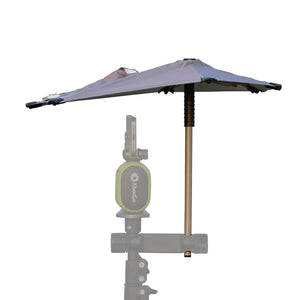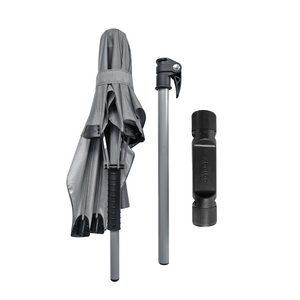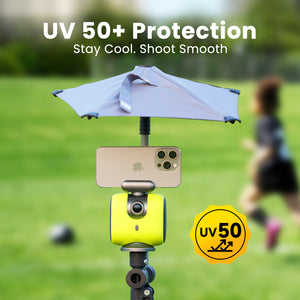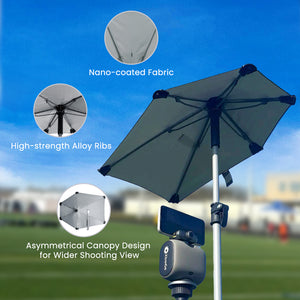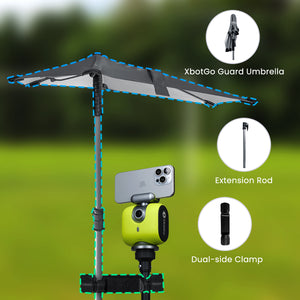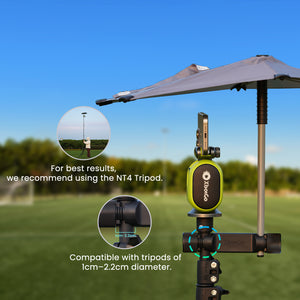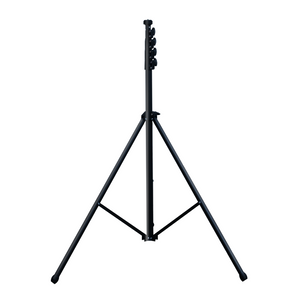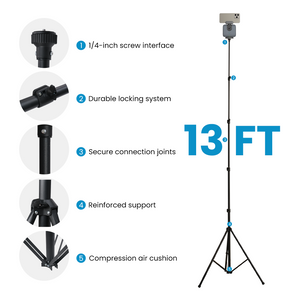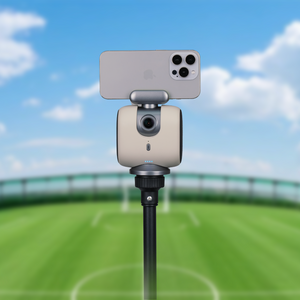XbotGo Chameleon AI Sports Camera
Basketball Rebound: Definition, Tips & Essential Skills
Every time a basketball hits the rim and doesn't go in—which happens more than half the time in any game—there's a golden opportunity waiting to be seized. That opportunity is called a rebound, and it's the difference between winning teams and losing ones.
Understanding Basketball Rebounds
Official Definition and Statistical Impact
A rebound in basketball occurs when a player gains possession of the ball after a missed field goal or free throw attempt. It's that simple in definition, yet profoundly complex in execution. The player who secures the ball is credited with the rebound, whether they catch it cleanly in the air or control it after it bounces on the floor.
Here's the reality that makes rebounding so crucial: even NBA teams—the best basketball players in the world—miss more than 50% of their shots. In youth and amateur basketball, that percentage climbs even higher. Every missed shot creates a 50/50 battle for possession, and the team that wins more of these battles typically wins the game.
Offensive vs Defensive Rebounds Explained
Not all rebounds are created equal. Understanding the distinction between offensive and defensive rebounds is fundamental to grasping their strategic importance:
Defensive Rebounds occur when the defending team secures the ball after the opposing team's missed shot. These rebounds:
- End the opponent's possession
- Prevent second-chance scoring opportunities
- Allow transition to offense
- Account for approximately 70-75% of all rebounds
Offensive Rebounds happen when the shooting team recaptures their own miss. These rebounds:
- Provide second-chance scoring opportunities
- Often lead to high-percentage shots near the basket
- Demoralize the defense
- Can shift game momentum dramatically
Why Rebounding Determines Game Outcomes
The math is simple but powerful: more rebounds equal more possessions, and more possessions equal more scoring opportunities. Teams that dominate the boards often shoot lower percentages yet still win games because they get multiple attempts per possession.
Consider this: if your team grabs just three more offensive rebounds than your opponent and converts half of those second chances, that's potentially a 9-point swing in a game often decided by single digits. It's no wonder coaches at every level preach that "rebounds win championships."
The Evolution from Traditional to Modern Rebounding
Why Old-School Box Outs Don't Work Anymore
For decades, basketball players learned the traditional "butt-to-gut" box out technique: turn your back to the opponent, make contact with your rear end, and hold position. This method worked when players were less athletic and the game moved slower.
Today's reality is different. Modern basketball players are stronger, faster, and more explosive than ever before. They'll simply jump over a traditional box out or use their athleticism to maneuver around static positioning. The old-school method has become a liability against today's athletes.
The "Swapping" Revolution for Modern Athletes
Enter the "swapping" technique—a game-changing approach developed for the modern game. Instead of turning your back completely, you:
- Make initial contact with your forearm to the opponent's chest
- Stop their forward momentum without losing sight of the ball
- Immediately pursue the basketball while maintaining contact
This technique keeps you mobile, aware, and ready to react. You're not locked into a static position that athletic players can exploit. The swapping method has become standard at elite levels because it combines the control of traditional boxing out with the mobility modern rebounding demands.
Advanced Positioning Intelligence
Smart rebounders understand that positioning beats pure athleticism. The "weak slice of the pie" strategy exemplifies this intelligence: since 70-80% of missed shots rebound to the opposite side of their origin, positioning yourself accordingly gives you a massive advantage.
Here's how to apply this knowledge:
- Shot from right corner? Position yourself on the left side of the rim
- Three-pointer from the top? Expect a long rebound straight back
- Left wing shot? Anticipate the ball coming to the right side
This isn't guesswork—it's physics combined with probability, and it's why players like Dennis Rodman dominated despite being undersized for their position.
Mental Mastery: The 90% Will Factor
Developing the Relentless Rebounder Mindset
Here's a truth that surprises many players: rebounding is 90% will and only 10% skill. The best rebounders in basketball history weren't necessarily the tallest or most athletic—they simply wanted the ball more than anyone else on the court.
This relentless mentality means:
- Being willing to crash the boards 20 times even if you get zero rebounds
- Never assuming a shot will go in
- Pursuing every rebound like the game depends on it
- Maintaining effort when fatigue sets in
The mental approach separates good rebounders from great ones. It's about developing what coaches call "motor"—that non-stop engine that keeps you pursuing rebounds when others have given up.
How Shorter Players Dominate Taller Opponents
Height helps in basketball, but rebounding proves it's not everything. Players standing 5'8" to 6'0" routinely out-rebound opponents half a foot taller through:
Superior Positioning: Getting to spots first matters more than reaching highest
Better Timing: Knowing when to jump beats jumping highest
Lower Center of Gravity: Provides stability and leverage advantages
Relentless Effort: Out-hustling taller players who rely on height alone
The key is using what you have—speed, positioning, timing, and heart—to neutralize height advantages. When a shorter player consistently beats a taller one to rebounds, it's rarely luck; it's preparation meeting opportunity.
Reading Situations and Opponents
Elite rebounders develop an almost supernatural ability to read the game. They study:
- How different players tend to miss (short, long, left, right)
- Shot trajectories and their typical rebound patterns
- Opponent tendencies and weaknesses
- Court positioning of all players before the shot
This reading ability comes from experience and conscious observation. Great rebounders like Dennis Rodman famously spent hours studying how balls bounced off different rims, developing an intuitive understanding that gave them split-second advantages.
Advanced Rebounding Strategies & Techniques
Shot-Specific Positioning Patterns
Different shots produce predictable rebound patterns. Master these, and you'll find yourself in the right place more often:
Three-Point Shots:
- Typically produce long rebounds
- Often bounce back toward the shooter
- Guards have the advantage on these rebounds
Corner Shots:
- Usually continue through to the opposite side
- Rarely bounce back to the shooter
- Baseline positioning is crucial
High-Arc Shots:
- Tend to produce shorter, higher bounces
- Stay closer to the rim
- Require quick reactions and timing
Low-Arc/Line Drive Shots:
- Create longer, faster rebounds
- More unpredictable bounces
- Demand wider positioning
Offensive Rebounding Tactics (SOFO & Swimming)
Modern offensive rebounding requires craftiness to overcome defensive advantages. Two elite techniques have emerged:
SOFO (Spin Off First Object):The philosophy is simple: don't let the first contact stop your momentum. When a defender boxes you out:
- Accept the initial contact without "melting like soft butter"
- Use their momentum against them by spinning off
- Maintain forward progress toward the basketball
- Create new angles for rebounding opportunities
The Swimming Technique:This move borrowed from football pass rushing:
- Let the defender feel you on one side
- As they commit to blocking that direction
- "Swim" over to the opposite side
- Establish inside position before they can recover
Both techniques turn defensive advantages into offensive opportunities through misdirection and superior technique.
Team Rebounding Systems
Championship teams don't rely on individual rebounding—they implement systems:
Defensive Rebounding Assignments:
- Guards: Box out shooters and pursue long rebounds
- Forwards: Control the wings and weak-side rebounds
- Centers: Dominate the paint and primary rebounding zone
Strategic Abandonment:Smart teams identify non-shooting threats and abandon them to crash the boards. If your opponent can't shoot from certain positions, why guard them there? This creates numerical advantages in rebounding situations.
Communication Protocols:
- "Shot!" calls alert all teammates
- "Box out!" reminders during flight
- "Ball!" claims to avoid collisions
- "Outlet!" calls for fast break initiation
Training Methods for Rebounding Excellence
Individual Skill Development Drills
Wall Rebound Series:
- Throw ball high against wall
- Jump and catch with one hand at apex
- Secure with both hands before landing
- Progress to different angles and distances
Reactive Bounce Drill:
- Hold ball with both hands
- Jump and slam ball to ground at peak
- Land and immediately jump to secure rebound
- Develops second and third jump ability
Box Out Progression:
- Start with stationary contact holds
- Add movement while maintaining contact
- Incorporate live ball scenarios
- Progress to full-speed competition
Physical and Mental Conditioning
Physical Requirements:
- Core strength for maintaining position
- Leg power for explosive jumping
- Cardiovascular endurance for sustained effort
- Hand strength for ball security
Mental Training:
- Visualization of successful rebounds
- Film study of elite rebounders
- Developing "want-to" through goal setting
- Building confidence through preparation
The Rodman Method:Spend dedicated practice time just watching shots and predicting rebounds. Don't chase them initially—just observe and learn patterns. This develops the anticipation that separates good from great rebounders.
Conclusion
Rebounding in basketball is more than just grabbing missed shots—it’s where effort, smarts, and skill collide. True mastery means using modern techniques, hustling relentlessly, and always being in the right place. Every miss is your chance. Size matters less than heart and smart positioning. The boards don’t care how tall you are—only how much you want the ball.
XbotGo Chameleon AI Sports Camera
Capture every moment with AI-powered tracking. Perfect for coaches, parents, and athletes who want seamless footage without manual filming.







 Soccer
Soccer Basketball
Basketball Ice Hockey
Ice Hockey Rugby
Rugby










